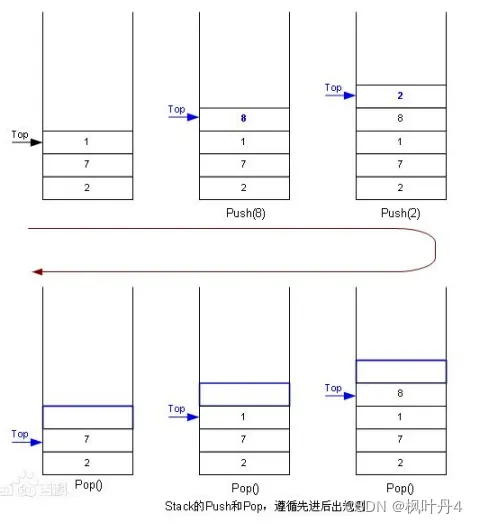目录
1 -> 栈
1.1 -> 栈的概念及结构
1.2 -> 栈的实现
1.2.1 -> Stack.h
1.2.2 -> Stack.c
1.2.3 -> Test.c
2 -> 队列
2.1 -> 队列的概念及结构
2.2 -> 队列的实现
2.2.1 -> Queue.h
2.2.2 -> Queue.c

1 -> 栈
1.1 -> 栈的概念及结构
栈:一种特殊的线性表,其只允许在固定的一端进行插入和删除元素操作。进行数据插入和删除操作的一端称为栈顶,另一端称为栈底。栈中的数据元素遵守后进先出LIFO(Last In First Out)的原则。
压栈:栈的插入操作叫进栈/压栈/入栈,入数据在栈顶。
出栈:栈的删除操作叫做出栈。出数据也在栈顶。


1.2 -> 栈的实现
栈的实现一般可以使用数组或链表实现,相对而言数组的结构实现更优。因为数组在尾上插入数据的代价比较小。


1.2.1 -> Stack.h
#pragma once
#define _CRT_SECURE_NO_WARNINGS 1
#include <stdio.h>
#include <assert.h>
#include <stdbool.h>
// 定长的静态栈的结构,实际中一般不实用
//typedef int STDataType;
//#define N 10
//typedef struct Stack
//{
// STDataType a[N];
// int top;
//}ST;
// 动态增长的栈
typedef int STDataType;
typedef struct Stack
{
STDataType* a;
int top;
int capacity;
}ST;
// 栈的初始化
void STInit(ST* pst);
// 栈的销毁
void STDestroy(ST* pst);
// 入栈
void STPush(ST* pst, STDataType x);
// 出栈
void STPop(ST* pst);
// 获取栈顶元素
STDataType STTop(ST* pst);
// 判空
bool STEmpty(ST* pst);
// 栈的有效元素个数
int STSize(ST* pst);1.2.2 -> Stack.c
#include "Stack.h"
// 栈的初始化
void STInit(ST* pst)
{
assert(pst);
pst->a = NULL;
pst->top = 0;
pst->capacity = 0;
}
// 栈的销毁
void STDestroy(ST* pst)
{
assert(pst);
free(pst->a);
pst->a = NULL;
pst->top = 0;
pst->capacity = 0;
}
// 入栈
void STPush(ST* pst, STDataType x)
{
if (pst->top == pst->capacity)
{
int newCapacity = pst->capacity == 0 ? 4 : pst->capacity * 2;
STDataType* tmp = (STDataType*)realloc(pst->a, newCapacity * sizeof(STDataType));
if (tmp == NULL)
{
perror("realloc fail");
return;
}
pst->a = tmp;
pst->capacity = newCapacity;
}
pst->a[pst->top] = x;
pst->top++;
}
// 出栈
void STPop(ST* pst)
{
assert(pst);
assert(!STEmpty(pst));
pst->top--;
}
// 获取栈顶元素
STDataType STTop(ST* pst)
{
assert(pst);
assert(!STEmpty(pst));
return pst->a[pst->top - 1];
}
// 判空
bool STEmpty(ST* pst)
{
assert(pst);
return pst->top == 0;
}
// 栈的有效元素个数
int STSize(ST* pst)
{
assert(pst);
return pst->top;
}1.2.3 -> Test.c
#include "Stack.h"
void Test1()
{
ST st;
STInit(&st);
STPush(&st, 1);
STPush(&st, 2);
printf("%d\n", STTop(&st));
STTop(&st);
STPush(&st, 3);
STPush(&st, 4);
STPush(&st, 5);
while (!STEmpty(&st))
{
printf("%d ", STTop(&st));
STPop(&st);
}
STDestroy(&st);
}
int main()
{
Test1();
return 0;
}2 -> 队列
2.1 -> 队列的概念及结构
队列:只允许一端进行插入数据操作,在另一端进行删除数据操作的特殊线性表,队列具有先进先出FIFO(First In First Out)。
入队列:进行插入操作的一端称为队尾。
出队列:进行删除操作的一端称为队头。

2.2 -> 队列的实现
队列也可以用数组和链表的结构实现,使用链表的结构实现更优,因为如果使用数组的结构,出队列在数组头上出数据,效率较低。

2.2.1 -> Queue.h
#pragma once
#define _CRT_SECURE_NO_WARNINGS 1
#include<stdlib.h>
#include<assert.h>
#include<stdbool.h>
// 链式结构: 表示队列
typedef int QDataType;
typedef struct QueueNode
{
struct QueueNode* next;
QDataType data;
}QNode;
typedef struct Queue
{
QNode* phead;
QNode* ptail;
int size;
}Queue;
// 队列的初始化
void QueueInit(Queue* pq);
// 队列的销毁
void QueueDestroy(Queue* pq);
// 队尾入队列
void QueuePush(Queue* pq, QDataType x);
// 队头出队列
void QueuePop(Queue* pq);
// 获取队头元素
QDataType QueueFront(Queue* pq);
// 获取队尾元素
QDataType QueueBack(Queue* pq);
// 获取队列中有效元素个数
int QueueSize(Queue* pq);
// 判空
bool QueueEmpty(Queue* pq);2.2.2 -> Queue.c
#include "Queue.h"
// 队列的初始化
void QueueInit(Queue* pq)
{
assert(pq);
pq->phead = NULL;
pq->ptail = NULL;
pq->size = 0;
}
// 队列的销毁
void QueueDestroy(Queue* pq)
{
assert(pq);
QNode* cur = pq->phead;
while (cur)
{
QNode* next = cur->next;
free(cur);
cur = next;
}
pq->phead = NULL;
pq->ptail = NULL;
pq->size = 0;
}
// 队尾入队列
void QueuePush(Queue* pq, QDataType x)
{
assert(pq);
QNode* newnode = (QNode*)malloc(sizeof(QNode));
if (newnode == NULL)
{
perror("malloc fail");
return;
}
newnode->data = x;
newnode->next = NULL;
if (pq->ptail == NULL)
{
assert(pq->phead == NULL);
pq->phead = newnode;
pq->ptail = newnode;
}
else
{
pq->ptail->next = newnode;
pq->ptail = newnode;
}
pq->size++;
}
// 队头出队列
void QueuePop(Queue* pq)
{
assert(pq);
assert(!QueueEmpty(pq));
if (pq->phead->next == NULL)
{
free(pq->phead);
pq->phead = NULL;
pq->ptail = NULL;
}
else
{
QNode* next = pq->phead->next;
free(pq->phead);
pq->phead = next;
}
pq->size--;
}
// 获取队头元素
QDataType QueueFront(Queue* pq)
{
assert(pq);
assert(!QueueEmpty(pq));
return pq->phead->data;
}
// 获取队尾元素
QDataType QueueBack(Queue* pq)
{
assert(pq);
assert(!QueueEmpty(pq));
return pq->ptail->data;
}
// 获取队列中有效元素个数
int QueueSize(Queue* pq)
{
assert(pq);
return pq->size;
}
// 判空
bool QueueEmpty(Queue* pq)
{
assert(pq);
return pq->size == 0;
}感谢各位大佬支持!!!
互三啦!!!
版权声明:本文为博主作者:枫叶丹4原创文章,版权归属原作者,如果侵权,请联系我们删除!
原文链接:https://blog.csdn.net/weixin_74809706/article/details/136542699
